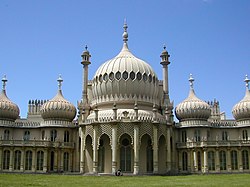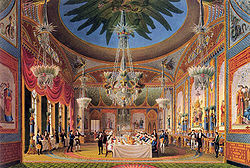Royal Pavilion
50°49′23″N 0°08′15″W / 50.82306°N 0.13750°W




The Royal Pavilion is a former royal residence located in Brighton, England. It was built in three campaigns, beginning in 1787, as a seaside retreat for George, Prince of Wales, from 1811 Prince Regent. It is often referred to as the Brighton Pavilion. It is built in the Indo-Saracenic style prevalent in India for most of the 19th century, with the most extravagant chinoiserie interiors ever executed in the British Isles.
History
The Prince of Wales, who later became King George IV, first visited Brighton in 1783, at the age of 21. The seaside town had become fashionable through the residence of George's uncle, the Prince Henry, Duke of Cumberland, whose tastes for cuisine, gaming, the theatre and fast living the young prince shared, and with whom he lodged in Brighton at Grove House. In addition, his physician advised him that the seawater would be beneficial for his gout. In 1786, under a financial cloud that had been examined in Parliament for the extravagances incurred in building Carlton House, London, he rented a modest erstwhile farmhouse facing the Steine, a grassy area of Brighton used as a promenade by visitors. Being remote from the Royal Court in London, the Pavilion was also a discreet location for the Prince to enjoy liaisons with his long-time companion, Mrs Fitzherbert. The Prince had wished to marry her, and did so in secrecy, as her Roman Catholicism ruled out marriage under the Royal Marriages Act.
In 1787 the designer of Carlton House, Henry Holland, was employed to enlarge the existing building, which became one wing of the Marine Pavilion, flanking a central rotunda, which contained only three main rooms, a breakfast room, dining room and library, fitted out in Holland's French-influenced neoclassical style, with decorative paintings by Biagio Rebecca. In 1801-02 the Pavilion was enlarged with a new dining room and conservatory, to designs of Peter Frederick Robinson, in Holland's office. The Prince also purchased land surrounding the property, on which a grand riding school and stables were built in an Indian style in 1803-08, to designs by William Porden that dwarfed the Marine Pavilion, in providing stabling for sixty horses.[1]
Between 1815 and 1822 the designer John Nash redesigned and greatly extended the Pavilion, and it is the work of Nash which can be seen today. The palace looks rather striking in the middle of Brighton, having a very Indian appearance on the outside. However, the fanciful interior design, primarily by Frederick Crace and the little-known decorative painter Robert Jones, is heavily influenced by both Chinese and Indian fashion (with Mughal and Islamic architectural elements). It is a prime example of the exoticism that was an alternative to more classicising mainstream taste in the Regency style.
Purchase by Brighton
After the death of George IV in 1830, his successor King William IV also stayed in the Pavilion on his frequent visits to Brighton. However, Queen Victoria disliked Brighton and the lack of privacy the Pavilion afforded her on her visits there especially once Brighton became accessible to Londoners by rail in 1841 and the cramped quarters it provided her growing family. She purchased the land for Osborne House in the Isle of Wight, which became the summer home of the royal family. After her last visit to Brighton in 1845, the Government planned to sell the building and grounds. The Brighton Commissioners and the Brighton Vestry successfully petitioned the Government to sell the Pavilion to the town for £53,000 in 1850 under the Brighton Improvement (Purchase of the Royal Pavilion and Grounds) Act 1850.[2] The town used the building as assembly rooms. Many of the Pavilion's original fixtures and fittings were removed on the order of the royal household at the time of the sale, most ending up either in Buckingham Palace or Windsor Castle. Queen Victoria returned to Brighton large quantities of unused fittings in the late 1860s. George V and Queen Mary returned more after the First World War. Since the Second World War, the municipality of Brighton has spent a great deal of time, effort and money restoring the Pavilion to its state at the time of King George IV, encouraged by the permanent loan of over 100 items of furniture from Queen Elizabeth II in the 1950s, and has undertaken an extensive programme of restoring the rooms, reinstating stud walls, and creating replicas of some original fittings and occasionally pieces of furniture.
First World War
During the First World War, the Pavilion, along with other sites in Brighton, was transformed into a military hospital. From November 1914 to early 1916, recovering soldiers from the Imperial Indian Army were stationed there - the adjacent Dome (now a theatre) was equipped with an operating room and more beds. The Pavilion was partly used in imperial efforts to convince potential Indian recruits that their wounded countrymen were being well treated: a series of photographs was produced, with the official sanction of the state, showing the resplendant rooms converted into hospital wards (few pictures were taken of the local workhouse, renamed the Kitchener Indian Hospital, now Brighton General Hospital, which housed the majority of wounded troops). The soldiers also received visits from Lord Kithchener in July 1915,and King George V in August of the same year who presented several soldiers with military honours. In 1916, the Indian Soldiers were moved on from Brighton after their redployment in the Middle East. By that stage, roughly 14,000 wounded Indian servicemen had passed through the town's hospitals. After that point, the Pavilion continued to be used as a hospital for wounded British soldiers until the end of the war in 1918.
Tourism
The purchase of the Royal Pavilion from Queen Victoria, by Brighton, marked the beginnings of the site’s tourism dominance through the Royal Pavilion’s transition from a private residence to a public attraction under civic ownership. Today, the Royal Pavilion has around 400,000 people visiting it annually.[3]
References in culture
- In the 1970 film On a Clear Day You Can See Forever, many of the flashback scenes were filmed at the Royal Pavilion.
- In Richard Attenborough's 1969 film Oh! What a Lovely War, the Music Room was used for the scene where the Austrian Emperor signs the declaration of war against Serbia.
- In the short animation The Snowman, the snowman and the boy fly over what seems to be Brighton; the Royal Pavilion and the Palace Pier can clearly be seen.
- It serves as the seaside retreat of King Edward in the 1995 version of Richard III, set in a dystopian 1930s Britain.
- In the episode "Dish and Dishonesty" of Blackadder the Third, Blackadder tells the Prince, who has been granted money by Parliament, to "take out the drawings for that beach hut at Brighton!", a reference to the Pavilion.
- In contemporary artist Fiona Tan's film A Lapse of Memory, an eccentric old man lives alone in a deserted building (Royal Pavilion).
- In the music video of All Time High sung by Rita Coolidge the Royal Pavilion features, seemingly as an Indian palace.
External links
- The Royal Pavilion and Museums' official website
- Images of the Royal Pavilion
- "The Royal Pavilion and Museums Foundation".
- "Map Of Brighton - Brighton Map based information". Retrieved 2008-05-11.
References and notes
- ^ David Beevers, ed., The Royal Pavilion, Brighton: Souvenir Guide and Catalogue 2008:5.
- ^ Dale, Antony (1977). Brighton Town and Brighton People. Chichester: Phillimore. p. 221. ISBN 0-85033-219-2.
- ^ "Brighton | Tourist Information | History & Heritage | The Royal Pavilion |." Brighton, Hotels, Accommodation, B&B, Tourist Information. Web. <http://tourism.brighton.co.uk/history/bodypage.asp?subheading=The+Royal+Pavilion&url=History&mainheading=6>.
Further reading
- Dinkel, John, 1983. The Royal Pavilion, Brighton
- Morley, John, 1983. The Making of the Royal Pavilion
- Musgrave, Clifford, 1951. Royal Pavilion: A Study in the Romantic
- Musgrave, Clifford, 1959. Royal Pavilion: An Episode in the Romantic
- Roberts, Henry D, 1939. The History of the Royal Pavilion, Brighton
- Rutherford, Jessica M.F., 2003. A Prince's Passion: The life of the Royal Pavilion.
- Buildings and structures completed in 1815
- Buildings and structures in Brighton and Hove
- Country houses in Brighton and Hove
- Gardens in Brighton and Hove
- Royal residences in England
- Grade I listed buildings in Brighton and Hove
- Grade I listed houses
- Grade I listed palaces
- Museums in Brighton and Hove
- Historic house museums in Brighton and Hove
- Pavilions








